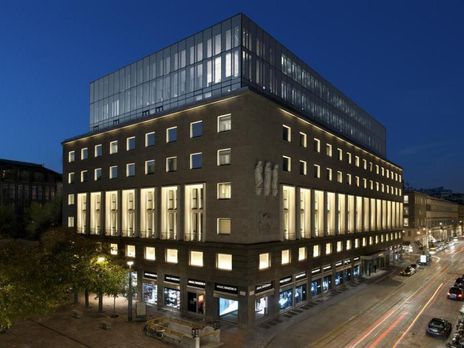

The block between Via Manzoni, Via dei Giardini, Via Croce Rossa and Via Gastone Pisone - an approximately 10,000-square-meter chunk of urban territory - is not just any ordinary city block. It is a cathedral for fashionistas and design fanatics coming from all over the world.
The Armani Manzoni 31 building is a Giorgio Armani micro-universe. It contains stores selling Armani high-end fashion collections and furniture, the suave Emporio Armani Caffe, the Nobu Armani-designed Japanese restaurant and the distinguished Armani Hotel Milano. The structure has become not only a fashion victim's paradise, but an important city landmark, embodying the exquisite style that has made Milan the design capital of the world.
Giorgio Armani is not only one of today's leading designers. His mild-mannered personality and profound acumen have also made him a towering figure in the world of culture and business. Armani was born in 1934 in the Lombard town of Piacenza, less than one hundred kilometers south of Milan. He studied medicine at the University of Milan, but stopped after his third year to enroll in the army. After his experience in the military he returned to Milan and became a window dresser at the La Rinascente department store next to the Duomo. He then began designing clothes for several fashion houses until meeting Sergio Galeotti, who became his professional and personal partner, and who convinced the talented designer to open his one office. The office was established in 1973 at 37 Corso Venezia next to the public gardens. Two years later the two entrepreneurs founded Giorgio Armani S.P.A, the beginning of the Armani Empire. By the late 70s the corporation had entered the American market, extending its influence on international trends and reaching diverse categories of clientele. Armani also designed costumes for films such as American Gigolo and The Untouchables, a move that introduced him to the world of cinema, where he made many friends. In 1985 Galeotti died of AIDS, leaving a profound trace on his partner's life.
By the 1990s the Giorgio Armani brand could be seen on all types of clothes and accessories: eyeglasses, sportswear, leather good, accessories, perfumes, cosmetics, furniture and gifts. Armani had also created a label for the mass market: Armani Exchange. Thus, the brand was associated not only with haute couture fashion, but with everyday clothes as well, clothes that were worn by people of all ages and incomes. Armani's friendships with many pop culture icons, such as Eric Clapton, Madonna and Sofia Lauren, made him a household name all over the world. In 2000 the Guggenheim Museum in New York organized an exhibition of Armani's work, the first ever for a living designer. Armani has even designed a phone for Samsung and recorded a CD with conceptual sounds and rhythms.
Giorgio Armani was heavily influenced by Japanese design and the philosophy of Zen. The minimalistic, square-patterned, somberly lit interiors of his cafes and restaurants allude to the introspective quality of Buddhism, which helps the individual obtain enlightenment from meditation and the faculty of intuition. The Nobu restaurant is basically a little piece of Japan in Europe. Its world-renowned chef Nobu Matsuhisa prepares dishes of such sophistication that for a split second it is possible to think that what has been placed in front of you is not food but some old Milanese jewel. The hotel on the top floors is an extension of Armani's subtle, restrained and soft-lit touch. It offers 95 guestrooms and suites, and besides its own lounge and restaurant, if also has a spa with breathtaking views of the Milanese skyline.
Whether you are admire Giorgio Armani's style or not, Milan's fame for aesthetic perfection would not be complete with the Armani Manzoni 31 Complex. The building, or at least one of its numerous facilities, is definitely worth a visit.